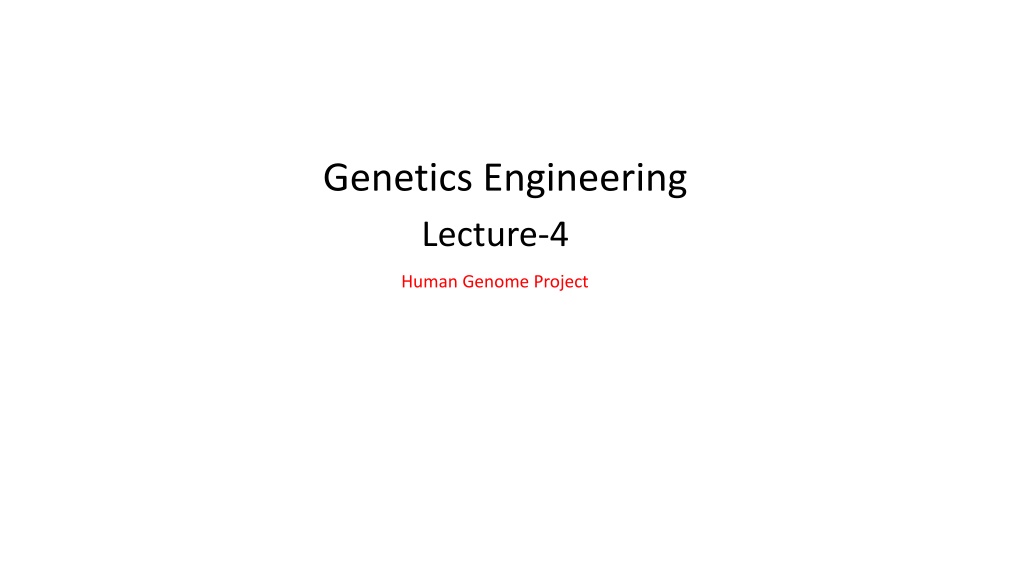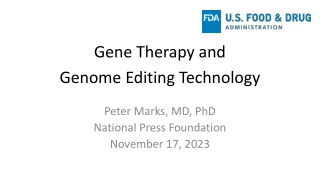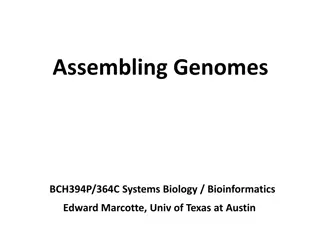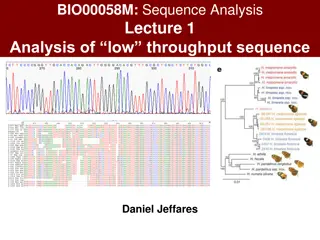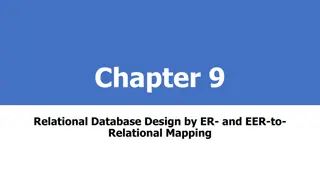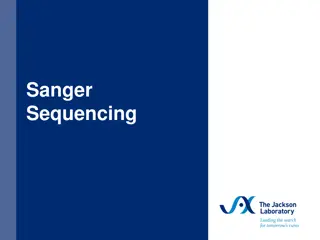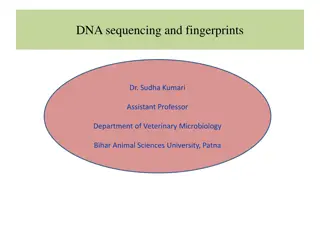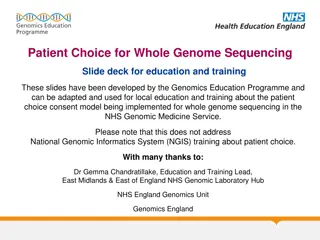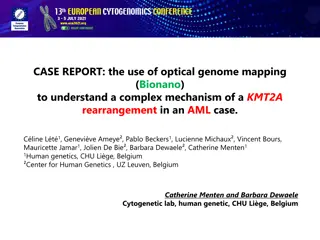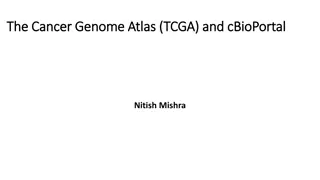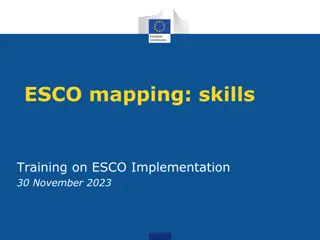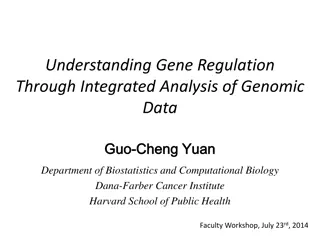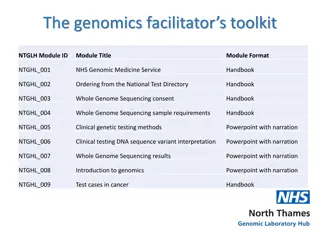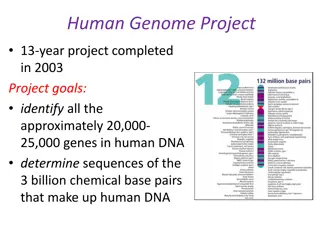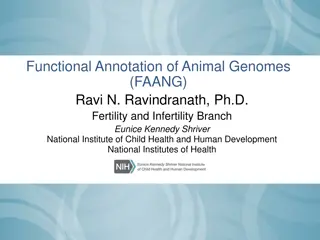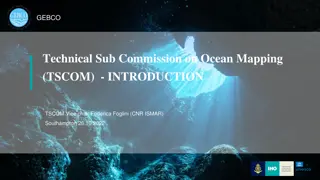Human Genome Project: Mapping and Sequencing Progress
The Human Genome Project (HGP) was an international research program aimed at mapping and understanding human genes. Researchers focused on sequencing DNA bases, creating gene location maps, and producing linkage maps to track inherited traits. The timeline highlights key milestones from the project's inception in 1988 to the successful completion of the pilot phase in 1999.
Download Presentation

Please find below an Image/Link to download the presentation.
The content on the website is provided AS IS for your information and personal use only. It may not be sold, licensed, or shared on other websites without obtaining consent from the author.If you encounter any issues during the download, it is possible that the publisher has removed the file from their server.
You are allowed to download the files provided on this website for personal or commercial use, subject to the condition that they are used lawfully. All files are the property of their respective owners.
The content on the website is provided AS IS for your information and personal use only. It may not be sold, licensed, or shared on other websites without obtaining consent from the author.
E N D
Presentation Transcript
Genetics Engineering Lecture-4 Human Genome Project
The Human Genome Project (HGP) was the international, collaborative research program whose goal was the complete mapping and understanding of all the genes of human beings. All our genes together are known as our "genome." HGP researchers undid the human genome in three major ways: 1- Determining the order, or "sequence," of all the bases in our genome's DNA. 2- Making maps that show the locations of genes for major sections of all our chromosomes. 3-Producing linkage maps, through which inherited traits (such as those for genetic disease) can be tracked over generations.
1988 1990 February 29-March 1: National Institutes of Health Director James Wyngaarden assembles scientists, administrators and science policy experts in Reston to lay out a plan for the Human Genome Project. October 1: The Office for Human Genome Research is created within the Office of the Director, National Institutes of Health. April: A 5 years plan with specific goals for the project is published. October 1: The Human Genome Project officially begins. 1992 James Watson resigns as first director of the National Center for Human Genome Research. Michael Gottesman is appointed acting NCHGR director 1989 1993 The National Center for Human Genome Research is established to carry out the National Institutes of Health's component of the United States Human Genome Project. The center's first director is James D. Watson, co-discoverer with Francis Crick of the double-helical structure of DNA. Francis S. Collins is appointed director of the National Center for Human Genome Research. 1994 First Human Genome Project Mapping Goal Is Met An international team of researchers has published a detailed linkage map of the human genome, meeting one of the project's scientific goals a full year ahead of schedule.
1996 1998 Pilot Study Explores Feasibility of Sequencing Human DNA The National Human Genome Research Institute (NHGRI), a key player in the international Human Genome Project (HGP) and part of the National Institutes of Health (NIH), announced today the launch of an unprecedented pilot study to explore the feasibility of large-scale sequencing of human DNA. Genome Project Leaders Announce Intent to Finish Sequencing the Human Genome Two Years Early At a meeting today of the federal Human Genome Project's main advisory body, project planners will present a new plan to finish the DNA sequence of the human genome by the end of year 2003, two years ahead of its original schedule.
1999 March: Human Genome Project Announces Successful Completion of Pilot Project The international Human Genome Project (HGP) today announced the successful completion of the pilot phase of sequencing the human genome and the launch of the full-scale effort to sequence all 3 billion letters (referred to as bases) that make up the human DNA instruction book. May: International Human Genome Sequencing Consortium Backs Rapid Construction of a Working Draft and Stands Firm on Public Access Following a meeting at Cold Spring Harbor Laboratory this week, leaders of the international human genome sequencing consortium reaffirmed their commitment to providing free, immediate and unrestricted access to human sequencing data. December: Scientists Complete First Chapter of Book of Life With Decoding of First HumanChromosome An international team of researchers has achieved a scientific milestone by unraveling for the first time the genetic code of an entire human chromosome.
2000 March: The Human Genome Project international consortium announced today that two billion of the three billion "letters" that constitute the genetic instruction book of humans have been deciphered and deposited into GenBank. June: International Human Genome Sequencing Consortium Announces "Working Draft" of Human Genome The Human Genome Project (HGP) public consortium today announced that it has assembled a working draft of the sequence of the human genome - the genetic blueprint for a human being. Two Thirds of Human DNA Script Deciphered by Human Genome Project November: NIH Consumer Day 2000 To Explain Impact of Human Genome Project on Public Health The National Human Genome Research Institute (NHGRI) at the National Institutes of Health (NIH) will sponsor "Consumer Day 2000" on Thursday, November 9, to inform patients, families and health care providers about how the Human Genome Project (HGP) will impact health and the prevention, diagnosis and treatment of diseases from Alzheimer's to strokes..
2001 International Human Genome Sequencing Consortium Publishes Sequence and Analysis of The Human Genome Project international consortium today announced the publication of a draft sequence and initial analysis of the human genome. the Human Genome 2003 April 14: International Consortium Completes Human Genome Project The International Human Genome Sequencing Consortium, led in the United States by the National Human Genome Research Institute (NHGRI) and the Department of Energy (DOE), today announced the successful completion of the Human Genome Project more than two years ahead of schedule. May 20: Progress Made in Sequencing Of Model Organisms' Genomes As efforts to build working drafts of the honeybee and chimpanzee genomes near completion, scientists are moving forward to sequence the genomes of other important model organisms.
2004 March 24: International Sequencing Consortium Launches Online Resource The National Human Genome Research Institute announces that the International Sequencing Consortium (ISC) has launched a free, online resource where scientists and the public can get the latest information on the status of sequencing projects for animal, plant and other eukaryotic genomes. March31: Scientists Compare Rat An international research team, supported by the National Institutes of Health (NIH), today announced it has completed a high-quality, draft sequence of the genome of the laboratory rat, and has used that data to explore how the rat's genetic blueprint stacks up against those of mice and humans. Genome With Human, Mouse October 20: International Human Genome Sequencing Consortium Describes Finished Human Genome The International Human Genome Sequencing Consortium, led in the United States by the National Human Genome Research Institute (NHGRI) and the Department of Energy (DOE), today published its scientific description of the finished human genome sequence, reducing the estimated number of human protein-coding genes from 35,000 to only 20,000-25,000, a surprisingly low number for our species. Sequence
This international effort to sequence the 3 billion DNA letters in the human genome is considered by many to be one of the most ambitious scientific undertakings of all time, even compared to splitting the atom or going to the moon. The finished sequence produced by the Human Genome Project covers about 99 percent of the human genome's gene-containing regions, and it has been sequenced to an accuracy of 99.99 percent. The project took on a wide range of other goals, from sequencing the genomes of model organisms to developing new technologies to study whole genomes. the international network of researchers has produced an amazing array of advances that most scientists had not expected until much later. including: 1-An advanced draft of the mouse genome sequence, published in December 2002; 2-An initial draft of the rat genome sequence, produced in November 2002; 3-The identification of more than 3 million human genetic variations, called single nucleotide polymorphisms (SNPs); 4-The generation of full-length complementary DNAs (cDNAs) for more than 70 percent of known human and mouse genes.
Reference https://www.genome.gov/human-genome-project
